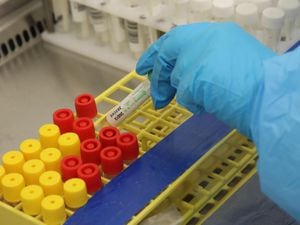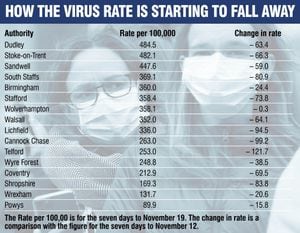Region on a knife edge in its battle to avoid harshest Tier 3 restrictions
When it comes to determining the level of Covid restrictions faced by parts of the Midlands, a day can make all the difference.

On Saturday night it looked certain that due to high levels of infection, large swathes of the region would be plunged into Tier 3 when the current national lockdown ends on December 2.
But since then rates have fallen sharply, suggesting lockdown measures may well be having the desired effect, and raising the prospect of some areas avoiding the harshest measures.
It means that as Boris Johnson prepares to announce a new set of localised restrictions tomorrow, the majority of the region finds itself on a knife edge between the top two tiers.
The decision will have a huge impact on our lives. Under Tier 2, pubs and bars that serve meals can open, as can cinemas and other forms of indoor entertainment. Up to 2,000 fans will be allowed into football stadiums, while indoor live performances for up to 1,000 people will be allowed.
In Tier 3 all of this will be off limits, meaning boozers could be closed over Christmas. While Shrewsbury may get fans if Shropshire pushes into Tier 2, that won’t be the case if the Black Country stays in Tier 3. Albion, Villa, Wolves and Saddlers fans would have to kiss goodbye to any chance of seeing their team in action at stadiums until next year.
It is worth remembering that when the national lockdown was first announced on October 31, the entire West Midlands had been on the brink of being placed under the old Tier 3 restrictions.
At that point in time infection rates and case numbers in many areas were lower than they are now.
And the comments from Ministers in recent days do not bode well.
The Prime Minister said that under the new system, “many more places” will find themselves under tighter restrictions, while Transport Secretary Grant Shapps said it was likely that half the country may be placed in the strictest alert level.
However, there are reasons for optimism.
In the seven days to November 19, the infection rate dropped by 12 per cent in Dudley to 484.5 per 100,000 population. In Sandwell it fell by the same amount to 447.6.
Both areas are in the top 10 in the country for infection rates, with a combined total of 3,028 new cases, but following weeks of rising rates the figures have finally started to head in the right direction.
The scenario has been repeated across the region. Stafford has seen a drop of 15 per cent to 358.4, while in South Staffordshire the rate has decreased by 18 per cent over the week.

If any of these areas are to escape the highest level of restrictions, then the downward trajectory will need to continue over the next 24 hours ahead of the announcement of the Government’s final decision.
Another issue still to be decided is how to localise the restrictions. Ministers are understood to have moved away from the idea of region-wide measures due to the differences in infection rates in places that are a relatively short distance apart.
It would, for example, be hard to justify putting Telford – which has a rate of 253 per 100,000 and has seen cases fall by 219 over the last week – under the same restrictions as the Black Country. Restrictions are expected to be determined by upper tier local authority boundaries, meaning in theory at least, Wolverhampton could be placed at a different alert level than neighbouring Dudley.
Contrary to some reports, alert levels are expected to be regularly reviewed, so a borough facing the tightest restrictions can still change Tiers later.
West Midlands Mayor Andy Street has held talks with Ministers over the region’s position. He says no conclusions have yet been reached and that the final decision would not be made until a short time before tomorrow’s announcement.
The Mayor said it was “absolutely critical” that the decision was made “as late as possible” to allow the rate of infection and case numbers to fall further. “It really is a case of every day counting,” he added.
Elsewhere in the country, health chiefs have hailed the impact of higher level restrictions. In the week up to October 5 Nottingham had the highest infection rate in England at 689.1 cases per 100,000 people. The rate is now 225 per 100,000, with new cases down to 749.
Liverpool, too, has seen a dramatic fall after measures were put in place early.





